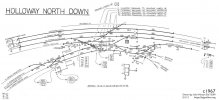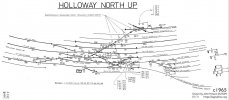Martin Shaw
Western Thunderer
We have had a considerable number of Tim's pics around Holloway North and South which to the uninitiated was a complex area with many running lines and a forest of signals which aren't always obvious. To assist me and anyone else who is perplexed I have been given permission to post the 4 Holloway signal box diagrams which should help identify things. If anyone has any questions about signalling matters that arise from the diagrams I will do my best to answer them.
Most importantly please note that these four diagrams are posted with the explicit permission of and copyright retained by John Hinson.




Most importantly please note that these four diagrams are posted with the explicit permission of and copyright retained by John Hinson.









 as I read that as heading straight on and not diverging to the left and straight on leads to join the up slow. I get the principle of the two equal height post being for separate lines.
as I read that as heading straight on and not diverging to the left and straight on leads to join the up slow. I get the principle of the two equal height post being for separate lines.

 .
. I will not, however, be doing another one in a hurry.
I will not, however, be doing another one in a hurry.



